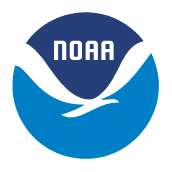GSL’s Hazard Services Team receives National Weather Association Award

The GSL Hazard Services Team has received the National Weather Association Larry R. Johnson Special Award. Because of their work, 20 NOAA National Weather Service (NWS) Offices were able to evaluate and issue long-duration winter and non-precipitation weather watches, warnings, and advisories for millions of people from 2020-2022, years ahead of the operational transition in 2023-2024.
NOAA GSL leads the development of new Hazard Services software capabilities to support forecast and warning operations at National Weather Service (NWS) and National Centers for Environmental Prediction offices. Since FY18, GSL has been developing new watch/warning/advisory capabilities for over 50 long-duration Winter Weather, Non-Precipitation Weather, and Marine hazards. The winter threats include blizzard conditions, heavy snow, freezing rain, and ice events. These products provide critical information to core partners to help plan prior to a major winter event that can cause over a billion dollars of damage in just a few days. The non-precipitation threats include extreme heat or cold, dense fog and smoke, high winds, and volcanic ashfall that can last for hours or even days and can affect vulnerable populations that do not have access to a safe, sturdy, and climate-controlled shelter. The marine threats include severe winds, freezing sea spray, rough seas, and low visibility that can damage sea-faring vessels.
Due to the impacts of the COVID-19 pandemic, the operational implementation of these workflows became significantly delayed due to slowdowns in the releases of new Advanced Weather Interactive Processing System (AWIPS) updates, NWS office staffing shortages due to social distancing policies, and other factors amplified by the pandemic.
During this long period of uncertainty, the GSL team coordinated with the Office of Central Processing (CP) on the development of an AWIPS Test Authorization Note (ATAN) that allows for offices to opt-in and evaluate future Hazard Services software components. The goal was to further strengthen the performance and stability of the Hazard Services system and provide exposure to GSL’s new software capabilities. The Hazard Services ATAN had participation from around 1 out of 6 NWS offices from the Fall of 2020 to the present day.
GSL leads the development of new releases, user configuration documentation, training, and the demonstration of best practices on how to effectively use the Hazard Services software system. This Hazard Services ATAN has several demonstrated successes, including improved software tools and customizations, customer confidence in the system capabilities, and significant improvements to the Hazard Services architecture that will streamline the watch/warning/advisory creation process. Because of these successes, GSL will continue to manage the ATAN until these new hazard workflows are transitioned to operations in an effort to continue providing a forum for suggested improvements provided by NWS offices to be heard and taken into consideration by developers at GSL and provide even newer Hazard Services capabilities and software fixes to NWS offices sooner.
Offices initially began their evaluation of winter weather hazards by comparing the product generation workflow in Hazard Services to the legacy generation system and provided feedback back to GSL on weekly calls and a group email list managed by both GSL and CP on software. This iterative feedback process allowed for software changes to be developed by GSL and deployed rapidly back to offices for additional evaluation. By the middle of winter 2020, several offices became so confident with the Hazard Services software that they began issuing operational winter weather watches/warnings/advisories from Hazard Services to alert the public of imminent threats. By the late winter/early spring of 2021, more offices activated both Winter Weather and Non-Precipitation weather workflow for operational product generation. Several hundred Winter Weather and Non-Precipitation weather products were issued to the public by the end of Spring 2021.
Hazard Services was also used by offices affected by the unprecedented heatwave in the Pacific Northwest and the Nor’easters that affected the NWS offices in Caribou and Gray/Portland Maine. Without this field evaluation, it would have been over two years before such a widespread evaluation of these capabilities would have occurred and there would have been limited time to make any significant changes to the software.
Numerous offices have commended GSL for their work on this Hazard Services software preview. Some comments include:
- “I have been nothing short of impressed with how GSL has performed with Hazard Services. You often can fix problems in a matter of days and are very responsive to the needs of the field. I dare say if the rest of the applications were as efficient and responsive as GSL we would have a lot less issues in the field after a software upgrade. This program would be in serious trouble if GSL did not continue in its development!” – Phil K., Senior Meteorologist, NWS Green Bay, WI
- “Software developed by GSL is always nothing short of outstanding. Having been a NWS forecaster for 18 years and dealing with the software side of things for more than 12 years, I can say unequivocally that GSL software is the gold standard. Their technical ability, combined with their eagerness to fully understand the hows and whys of NWS operational software, including working directly with forecasters and field IT staff, results in a superior product for the agency.” – Jonathan L., Meteorologist, NWS Charleston, SC
- “GSL’s work on the Hazard Services Program has been nothing but impressive. The developers have been extremely quick to turnaround fixes and improvements that the field suggests. Often, these fixes come out in the next version of the ATAN, generally only a week or two down the road.” – Jennifer S., Meteorologist, NWS Albuquerque, NM
Our Mission
Lead research and directed development through the transition of environmental data, models, products, tools, and services to support commerce, protect life and property, and promote a scientifically literate public.
Research Areas
Organizational Excellence, Earth System Prediction, Advanced Technologies, and Decision Support are the foundation to achieving the GSL Grand Challenge: Deliver actionable global storm-scale prediction and environmental information through advanced technologies to serve society.
Global Systems Laboratory

